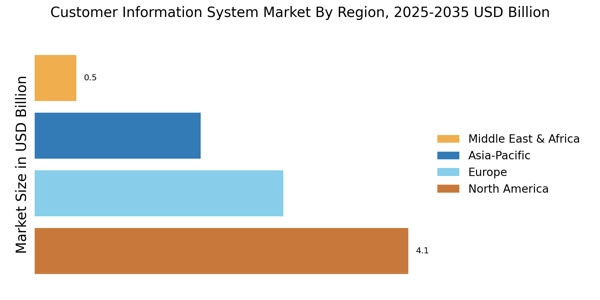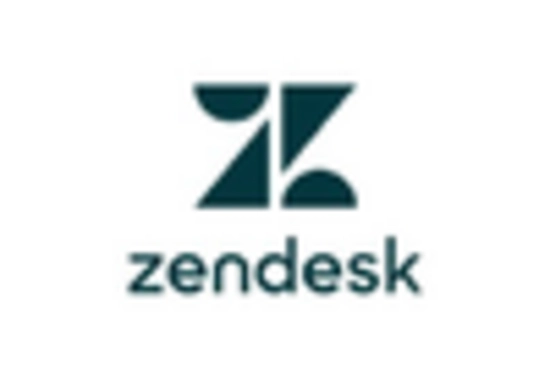Increased Focus on Customer Data Security
The Customer Information System Market is increasingly shaped by the heightened focus on customer data security. With the rise in data breaches and cyber threats, organizations are compelled to prioritize the protection of sensitive customer information. Regulatory frameworks and compliance requirements are becoming more stringent, necessitating the implementation of secure customer information systems. Companies that fail to safeguard customer data risk not only financial penalties but also reputational damage. As a result, investments in security measures, such as encryption and access controls, are surging. Recent reports suggest that the global spending on cybersecurity is projected to reach over 300 billion dollars by 2025. This emphasis on data security is likely to drive the growth of the Customer Information System Market, as businesses seek to enhance their security posture while maintaining customer trust.
Advancements in Data Analytics Technologies
The Customer Information System Market is significantly influenced by advancements in data analytics technologies. The proliferation of big data has enabled organizations to gather and analyze vast amounts of customer information, leading to more informed decision-making. Enhanced analytics tools allow businesses to identify trends, preferences, and behaviors, which can be leveraged to optimize marketing strategies and improve customer engagement. Recent statistics indicate that companies utilizing advanced analytics are 5 times more likely to make faster decisions than their competitors. This capability not only enhances operational efficiency but also drives innovation within the Customer Information System Market. As firms continue to adopt sophisticated analytics solutions, the demand for robust customer information systems is expected to rise, fostering a more data-driven approach to customer relationship management.
Rising Demand for Personalized Customer Experiences
The Customer Information System Market is witnessing a notable increase in demand for personalized customer experiences. Businesses are increasingly recognizing the importance of tailoring services to meet individual customer preferences. This trend is driven by the need to enhance customer satisfaction and loyalty, which are critical for long-term success. According to recent data, companies that effectively utilize customer information systems to analyze consumer behavior can achieve up to a 20% increase in customer retention rates. As organizations strive to differentiate themselves in competitive markets, the ability to leverage customer data for personalized interactions becomes paramount. This shift towards personalization is likely to propel the growth of the Customer Information System Market, as firms invest in advanced technologies to better understand and serve their clientele.
Integration of Omnichannel Customer Engagement Strategies
The Customer Information System Market is being driven by the integration of omnichannel customer engagement strategies. Businesses are increasingly adopting a holistic approach to customer interactions, ensuring a seamless experience across various channels, including online, mobile, and in-store. This strategy is essential for meeting the evolving expectations of consumers who demand consistency and convenience. Recent studies suggest that companies with strong omnichannel engagement strategies retain an average of 89% of their customers, compared to 33% for those with weak strategies. As organizations strive to enhance customer loyalty and satisfaction, the implementation of integrated customer information systems becomes crucial. This trend is likely to foster growth within the Customer Information System Market, as firms invest in technologies that support omnichannel capabilities.
Growing Adoption of Cloud-Based Customer Information Systems
The Customer Information System Market is experiencing a surge in the adoption of cloud-based solutions. Organizations are increasingly migrating their customer information systems to the cloud to benefit from enhanced scalability, flexibility, and cost-effectiveness. Cloud-based systems allow businesses to access customer data from anywhere, facilitating remote work and improving collaboration among teams. Recent data indicates that the cloud computing market is expected to grow at a compound annual growth rate of over 15% through 2026. This trend is particularly relevant for small and medium-sized enterprises that may lack the resources for on-premises infrastructure. As more companies recognize the advantages of cloud technology, the demand for cloud-based customer information systems is likely to escalate, further propelling the growth of the Customer Information System Market.


















Leave a Comment